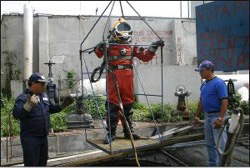
|
 |
 |
 News Around the Republic of Mexico | February 2008 News Around the Republic of Mexico | February 2008  
Mexico City Repairing Sewage Pipes to Avert Spill
 Mica Rosenberg - Reuters Mica Rosenberg - Reuters
go to original


| | Carlos Barrios Orta (C) is one of the divers who maintain Mexico City's 600-mile-long sewer system, clearing out debris so it won't back up into streets. (Mary Jordan/Washington Post) | | |
Mexico City - Mexico City, whose 20 million people produce enough sewage to fill an Olympic-sized swimming pool every minute, is fixing up its aging drainage system to avoid a pipe fracture that could flood entire neighborhoods, the subway and the airport with human waste.

Mayor Marcelo Ebrard on Tuesday unveiled a set of new pumps as the first part of a $1.2 billion spending plan to refurbish 160 km of sewer tunnels that have not been fully inspected for 15 years.

"The danger is very high because if the pipe fails, a flood would have serious consequences for the city," Ramon Aguirre, the head of the city's water system, told Reuters.

The first $56 million will go to build four new pumping stations that will increase the city's capacity to process the 40,000 litres of sewage it produces every second, marking the biggest investment in three decades.

"The problem of the drainage system, how to get the water out of the city, has been one of the primary concerns of this government," said Ebrard, gazing at a canal outside the city filled with greenish-black bubbling sludge.

Mexico City, built up by the Spanish on the Aztecs' floating capital in the middle of a lake, is constantly sinking, which causes the drainage canals to back up.

The six-metre-wide tunnels beneath the city are often clogged with objects dumped into sewers. A special team of divers wearing rubber suits wades through the filth to remove trash, animal carcasses and even human bodies.

Since the existing underground drainage system opened in 1975, the population has doubled, while the system's capacity to process effluent has dropped by 40 percent.

The move by the popular Ebrard stands in contrast to some of his less practical projects. These include setting up a giant ice skating ring in the central square, and trucking in sand to create artificial public beaches during the summer.

"Today we are able to tell the inhabitants of Mexico City that we are going to do the necessary repairs so there will be no serious flooding of our city," he said, as some listeners covered their noses with handkerchiefs to mask the stench.

But there is still much work to be done.

Only 12 percent of Mexico City's sewage is treated, a common practice in the developed world. The rest is sent north of the city to fertilize farm fields. | 
 | |
 |



